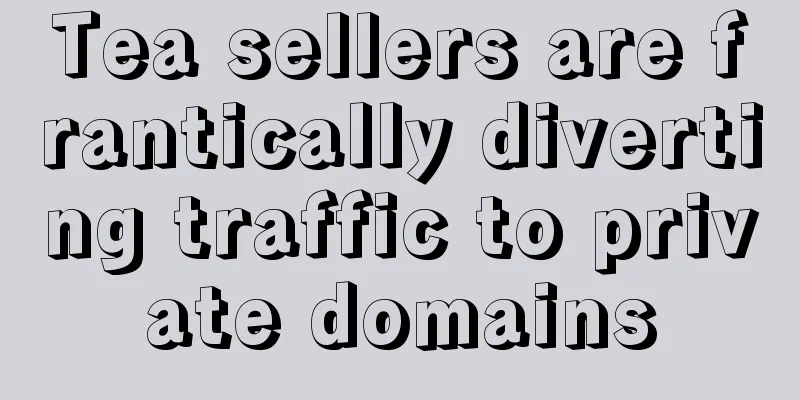Tea sellers are frantically diverting traffic to private domains

I don’t know if it’s due to algorithm recommendation or a special phenomenon before the Spring Festival, but now many tea marketing teams are frantically investing in traffic to attract users to WeChat private domains. In these traffic-investing ads, most of them are written in the style of “We are tea farmers, we skip the middlemen and sell directly, and the price is unbelievably low”. The frequency is so high that an ad selling tea will appear every 3-4 videos. If you pull down on the homepage, at least two ads from different teams will appear on each screen. Click to view, most of them jump to WeChat, or encourage adding WeChat, or jump to mini programs. Tea is not an isolated case. At this moment, some industries, including sea cucumbers and jade, are also seeing a surge in advertising. The methods of attracting traffic are mostly similar. Now, major platforms have long supported and allowed brand merchants to place advertisements and jump to other platforms for transactions. The above strategy benefits from this general background. But few people know that this is a rare opportunity to build a full domain and gather users from different platforms at merchants for long-term operations. In the past year, two major industries have benefited greatly. In the observation just mentioned, Jianshi saw that some marketing teams are using the "advertising + private domain" operation combination to start crazy internalization of some distinctive industries. 1. How to attract traffic?You may still remember some jokes about selling tea: a beautiful girl applies to add you as a friend, and when she is accepted, she claims that she may have added the wrong friend. In the subsequent chat, she will tell you that her grandfather has a tea plantation and she helps him sell tea, and asks if you can help buy some, etc. Now the situation has changed. When you open some short video platforms, you will find some people claiming to be tea farmers in front of the camera, saying that they can’t sell good tea even if they sell it at a low price, and you need to pay a high price to buy it, etc. Then, they will invite you to add WeChat. Such advertisements are growing at a very intensive rate. If you look at these ads together, you will find that the copywriting styles are very distinct and very similar: they seem to be multiple close teams. For example, common advertising copywriting styles include the following: Some claim to be tea farmers, or children of tea farmers. Because they can't stand the tricks of middlemen, factories, etc., they choose to open their own online stores and do WeChat business, hoping that more people can drink tea picked directly from their own homes. Or they claim to be source manufacturers, because they can't stand the price difference of middlemen and distributors, and sell cheap tea at unreasonable sky-high prices, so they sell it directly. Some also claim to be experts or practitioners, analyze that the market price of tea is too high, have their own price research on the market, and put up sales links. Regardless of which one, the videos show several large cans, each weighing 1 catties or more. If the traffic is directed to the mall, the product price will be directly marked, ranging from 99 to 199. If the traffic is directed to the private domain, most videos only focus on criticizing the inflated market prices, emphasizing that their products are very cheap and high-quality, without mentioning the price at all. The products covered by these copywritings almost include common categories of tea: white tea, Pu'er, berry tea, etc. At the same time, there are two ways to divert traffic to WeChat private domain: one is to directly display the WeChat QR code after clicking the ad, and scan the code to add it. The other is to jump to WeChat and a small program page will pop up, where the personal WeChat account will be disclosed to guide users to add it. This small program that jumps to is like a standard template, which is very simple. 2. In addition to tea, what other industries are doing this?Coincidentally, Jianshi has observed that not only tea, but also liquor, purple clay teapots, jade and other categories have begun to increase advertising . Some traffic diversion strategies have also begun to learn from the tea method to divert users to private domains. Many industry practitioners remind that the timing of the surge in investment is related to the current situation: the Spring Festival is approaching, and the demand for gifts among many people has skyrocketed. Including liquor, tea, purple clay teapots, Jianzhan, jade, etc., the demand for gifts for relatives and friends has skyrocketed. Even if there is no investment, the exposure rate of these products has also increased significantly. Jianshi contacted a well-known tea sales chain brand, and the other party told Jianshi that they also focused on advertising during this period. However, the brand did not divert traffic to the private domain, but diverted traffic to e-commerce platforms such as Tmall and JD.com for conversion. The ROI during this period before the Spring Festival can even reach about 1:10. In the face of this data, plus there is still a large amount of public domain traffic to consume, there is no promotion to precipitate in the private domain. According to its data, the ROI of the teams that divert traffic to the WeChat private domain may only be higher, otherwise the ratio would not be so different from that of diverting traffic to the micro mall. During this period, Jianshi also consulted the officials of several major platforms. One of them told Jianshi that the platform did not have a corresponding tea industry sales team, which looked more like a spontaneous behavior of the merchants. It should be mentioned that some product categories that promote "advertising + diverting traffic to the private domain" have distinct characteristics in themselves: tea, liquor, purple clay pots, Jianzhan, jade and other products. Although the categories are clear, some brand advantages are not obvious. On the contrary, the advantages of the place of origin are more prominent . At the same time, the consumer group is clear and the frequency is fixed, which is almost a perfect private domain user pool. This is why some industries are now growing rapidly in the above way. It also shows that industries with the same characteristics will be very suitable for similar gameplay. In particular, some private domain managers of brands believed in discussions in the Jianshi community that white-label products that hope to rise quickly in these industries are almost the first choice for similar gameplay. It is estimated that many Jianshi fans can tell which platforms some of the screenshots come from just by the page style. During the end-of-year series of live broadcasts promoted by Jianshi, a guest mentioned one of the platforms and believed that it was a very good investment platform that could obtain relatively accurate users. One of the reasons is that the core users of the platform are between 34 and 42 years old, which happens to be the main audience of the above categories. 3. Is there anything in particular to worry about?It is worth mentioning that when some practitioners in the tea industry discussed this phenomenon with Jianshi, a common phrase was "the marketing team came in." This is similar to the phrase "barbarians came to the door" during the previous company mergers and acquisitions. Regardless of whether they are marketing teams or not, according to this statement, some teams are using the "advertising + private domain" operation combination to madly roll back some distinctive industries. For veteran practitioners in these industries, it is actually a dilemma: should they follow or not? If you don't follow, you will see the sales pressure increase and users being snatched away. If the gameplay of "advertising + diverting traffic to private domain" is established, the team that does not follow up will quickly become very passive. An industry that quickly rolls inward will obviously not make people happy. If you follow, the difficulty of private domain operation is already very high. Moreover, the story of the tea-selling girl a few years ago is still fresh in everyone's memory - that model that was very similar to WeChat business a few years ago was controversial because of its mixed reputation. When observing the comment sections of multiple short video ads, we found that there were many public negative reviews from users in the comment section, indicating that this link still has certain risks and challenges. Back to the logic of the private domain, if it can be done continuously, long-term, and stably, and consumers can be truly treated as family members, and trust and emotional connections can be established, "multi-platform advertising + diversion to the private domain" is still the most effective way for white-label products to rise, and it is also one of the best channels for these categories to continue to increase the number of repurchases and customer unit price. Interestingly, when Jianshishi observed these advertisements later, he found that several of the mini-program pages were quickly blocked by WeChat: they were either voluntarily cancelled and frozen, or suspended by WeChat officials. Author: Jianshi WeChat public account: Jianshi |
<<: Drifting in Hengdian: Dreams are about taking off, but reality is about falling
Recommend
How many sites does eBay have? Which one is easier to do business with?
Among cross-border e-commerce platforms, eBay is a...
How should brands set their prices?
In marketing, the price will directly affect the f...
Is Amazon's overseas self-operation reliable? Is it a third party?
Many people will open stores on Amazon. When openi...
How to use the “people-goods-field” model? Why is the Internet industry also discussing it?
In the field of data analysis, the people-goods-pl...
Weighing assassins target young people
A small bag of bulk food, a few ordinary chocolate...
How do express delivery companies operate in private domains? A complete analysis of SF Express’s private domain operations
Many businesses are still expanding their private ...
From the growth story of virtual anchors, we can see the diversified ecology of Douyin live broadcast
Starting from Douyin live broadcast, this article ...
Will I be detained if my foreign trade payment bank card is frozen? What is the reason for the freeze?
Merchants doing foreign trade business will have r...
Xiaohongshu sells cars, Mercedes-Benz relies on legs, NIO relies on face
Different dressing styles and shooting methods mak...
How to cancel Amazon membership automatic renewal? Steps
Now many friends have started to use the Amazon pl...
Tmall's new rules prohibit merchants from diverting traffic to WeChat private domains
Tmall’s new regulations prohibit the use of packag...
How to add a carousel to an independent website? Is it easy to build an independent website?
In today's Internet age, an excellent website ...
Does eBay have natural traffic? How to attract traffic from outside eBay?
Traffic is critical to the operation of e-commerce...
What should I do if Amazon cannot be opened? What is the reason?
When you urgently need to use Amazon, you will enc...
What kind of platform is Fordeal? Can I sell counterfeit goods?
Among the numerous e-commerce platforms, Fordeal, ...









